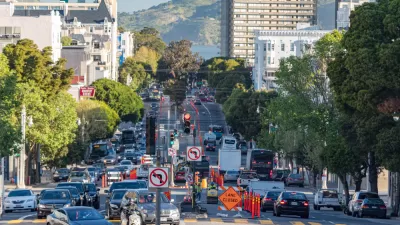While late to adopt bus rapid transit, San Francisco's Muni is planning to bring fully-fledged BRT lines, complete with dedicated lanes, to the city by 2010.
"Two bus rapid transit systems are already rolling in the Bay Area -- AC Transit's 72-R rapid bus along San Pablo Avenue in the East Bay -- and the Santa Clara Valley Transportation Authority's 522-Rapid between East San Jose and Palo Alto in the South Bay. Before the end of the year, AC Transit plans to launch a second speedy bus line from San Leandro to the UC Berkeley campus.
All three of those lines are minimalist versions of true bus rapid transit, relying on fewer bus stops and traffic signal. The most efficient bus rapid transit systems also have completely dedicated lanes and boarding platforms, for example.
Nevertheless, AC Transit spokesman Clarence Johnson said the 72-R service, which started in 2003, "is a real glowing success". A survey of riders found that more than half saved at least 10 minutes on the 72-R. Ridership, he said, "more than doubled."
"Both AC and VTA chose to start small, rolling out what they could afford, then eventually upgrading by adding dedicated lanes, miniature stations and ticket machines at bus stops, and other features."
"San Francisco's Muni, which hauls about 600,000 passengers a day, is taking a different approach. Rather than starting with the bare-bones version of bus rapid transit and upgrading, Muni plans to start with a full-featured system, including dedicated lanes, on bus lines on Van Ness Avenue and Geary Boulevards. They're expected to be in service by 2010 and 2011, respectively. The Van Ness line is expected to cost $65 million, the Geary line about $150 million."
"Each will feature high-capacity low-floor buses, dedicated lanes -- either on the sides or in the center of the road -- and high-quality bus shelters much like the Third Street light rail stations. They'll have real-time bus information and ticket vending machines, and they'll be 11 inches above the ground "so that passengers can walk on from the platform" without having to climb stairs, said Julie Kirschbaum, senior planner for the authority.
Muni will continue to run local buses that make regular stops -- but they won't be so speedy."
Thanks to MTC-ABAG Library
FULL STORY: Transportation planners cheer bus rapid transit

Planetizen Federal Action Tracker
A weekly monitor of how Trump’s orders and actions are impacting planners and planning in America.

San Francisco's School District Spent $105M To Build Affordable Housing for Teachers — And That's Just the Beginning
SFUSD joins a growing list of school districts using their land holdings to address housing affordability challenges faced by their own employees.

The Tiny, Adorable $7,000 Car Turning Japan Onto EVs
The single seat Mibot charges from a regular plug as quickly as an iPad, and is about half the price of an average EV.

As Trump Phases Out FEMA, Is It Time to Flee the Floodplains?
With less federal funding available for disaster relief efforts, the need to relocate at-risk communities is more urgent than ever.

With Protected Lanes, 460% More People Commute by Bike
For those needing more ammo, more data proving what we already knew is here.

In More Metros Than You’d Think, Suburbs are Now More Expensive Than the City
If you're moving to the burbs to save on square footage, data shows you should think again.
Urban Design for Planners 1: Software Tools
This six-course series explores essential urban design concepts using open source software and equips planners with the tools they need to participate fully in the urban design process.
Planning for Universal Design
Learn the tools for implementing Universal Design in planning regulations.
Smith Gee Studio
City of Charlotte
City of Camden Redevelopment Agency
City of Astoria
Transportation Research & Education Center (TREC) at Portland State University
US High Speed Rail Association
City of Camden Redevelopment Agency
Municipality of Princeton (NJ)




























